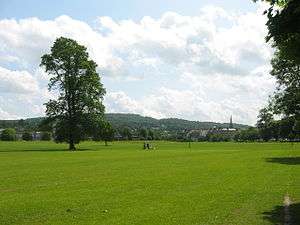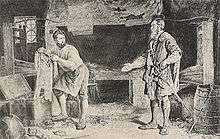Battle of the North Inch
| Battle of the North Inch | |||||||
|---|---|---|---|---|---|---|---|
| Part of Clan Cameron-Clan Mackintosh feud | |||||||
 Perth's North Inch in modern times, looking southeast towards the city's eastern edge. | |||||||
| |||||||
| Belligerents | |||||||
| Chattan Confederation or Clan Mackintosh | "Clan Kay" (Camerons or Davidsons?) | ||||||
| Strength | |||||||
| 30 | 30 | ||||||
| Casualties and losses | |||||||
| 19 | 29 | ||||||
The Battle of the North Inch (also known as the Battle of the Clans)[1] was a staged battle between the Chattan Confederation and the "Clan Kay" in September 1396. Thirty men were selected to represent each side in front of spectators that included King Robert III of Scotland and his court, on land that is now the North Inch park in Perth, Scotland.
The Chattan Confederation killed all but one of their opponents, at a cost of 19 deaths on their own side, and were awarded the victory. It is not clear whom they were fighting: it may have been their traditional enemies Clan Cameron[2] or it may have been Clan Davidson, in an internal dispute for precedence in the Chattan line of battle in future campaigns against the Camerons.
Background
According to historian Alexander Mackintosh Shaw, Clan Chattan was composed of MacKintoshes, MacPhersons, Davidsons, MacGillivrays and Macbeans, while Marshall's History of Perth states that "it is generally accepted that the Clan Chattan were the MacKintoshes, but, as always happens with the unfortunate, no sept or clan is willing to claim kindred with the Clan Kay".[3] Some historians identify Clan Kay with Clan Cameron, whose feud with the Chattans would last 360 years.
More recent historians, however, have suggested that the battle was an internal dispute between two clans from within Clan Chattan over who should take precedence in order of battle. This dispute had almost given the Camerons victory at the Battle of Invernahavon (1370 or 1386).
At the King's insistence, David Lindsay, 1st Earl of Crawford and Dunbar, had attempted to get the two feuding clans to settle their differences amicably. This failed, however, which led the two chiefs to put forth the notion of a trial by combat between members of the two parties, with the monarch awarding honours to the victors and a pardon to the defeated.
Battle
The clansmen agreed, and on a Monday morning in late September the clans marched through the streets of Perth, "to the sound of the pibroch and armed with bows and arrows, swords, targes, knives and axes,"[4] to the western banks of the River Tay. Barriers were erected on three sides of the Inch, in an attempt to keep spectators off the battlefield, with the Tay forming the natural fourth side to the east. The Gilded Arbour summerhouse of the Dominican Friary, which afforded those inside an excellent view of the Inch, was adapted into a grandstand for the King and his entourage.
Immediately prior to the commencement of the battle, it was discovered that Clan Chattan were short one man with 29. Some claim the absentee's courage had deserted him; another source states he had fallen sick. Whatever the case, the Chattans refused to fight at anything but full strength, and the opposition didn't offer to even up the numbers.

Just when it seemed that the battle would have to be abandoned, a substitute stepped forward by the name of Henry Smith. Also known by the names Hal o' the Wynd and the Gow-Chrom, Smith was a harness-maker and armourer in the town. "Small in stature, bandy-legged, but fierce," he was promised half a French crown of gold and the guarantee that he would be maintained for life if he survived. The offer was accepted, and the battle was given the go-ahead.
The most vivid, if not imaginative, account was written by Sir Walter Scott, in The Fair Maid of Perth thus:
| “ | The trumpets of the King sounded a charge, the bagpipes blew up their screaming and maddening notes, and the combatants, starting forward in regular order, and increasing their pace, till they came to a smart run, met together in the centre of the ground, as a furious land torrent encounters an advancing tide.
Blood flowed fast, and the groans of those who fell began to mingle with the cries of those who fought. The wild notes of the pipes were still heard above the tumult and stimulated to further exertion the fury of the combatants. At once, however, as if by mutual agreement, the instruments sounded a retreat. The two parties disengaged themselves from each other to take breath for a few minutes. About twenty of both sides lay on the field, dead or dying; arms and legs lopped off, heads cleft to the chin, slashes deep through the shoulder to the breast, showed at once the fury of the combat, the ghastly character of the weapons used, and the fatal strength of the arms which wielded them. |
” |
The battle resumed and continued until only eleven members of Clan Chattan (including Hal o' the Wynd)[4] and one of the Camerons was still alive. The latter, realising his was a lost cause, jumped into the Tay and swam to safety, handing victory to the Chattans.
References
- 1 2 Site Record for Perth, North Inch; 'The Battle Of The Clans'; Inch Of Perth, Royal Commission on the Ancient and Historical Monuments of Scotland
- ↑ Battle at the North Inch of Perth
- ↑ Sir Walter Scott, in his novel The Fair Maid of Perth, states that the clan opposing the Chattans was Clan Kay (or Quhele).
- 1 2 The Battle of the Clans at VisitDunkeld.com